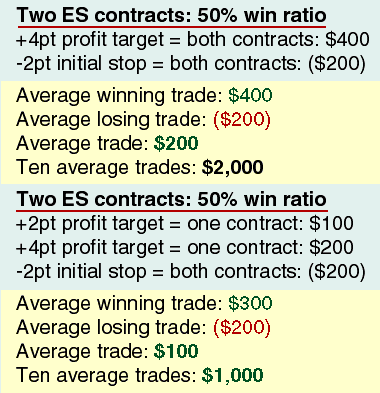About Those Early Exits
Partial Profits = Fiscal Folly?
Had I known that my career path would wind its way into professional trader status, I might have studied advanced mathematics with much more enthusiasm. After all, math is an exact science that does not lie. The way we assemble and interpret numbers to compile trading data may be subjective, but two plus two always equals four ... or does it?Is exiting a portion of your trade before your profit target is hit a viable strategy?
Somewhere along the way, many traders have been led to believe that taking partial profits -- that is, exiting some part of a trade before the necessary profit target is hit while letting the other part "run" -- is a viable tactic. The reasons for this seem to boil down to human emotions. Some followers of this practice suggest that partial gains taken early in a trade reduce stress and allow the trader to ride out the remaining contracts, while others suggest that taking partial profits protects against drawdown (maximum loss), should a trade reverse early to halfway through its execution.
NOT AS THEY APPEAR
On the face of it, taking partial profits may look like a professional tactic. It certainly has great appeal to new traders entering our game. But is it really as beneficial as it appears?
If we can agree that math is an exact science, why don't we take a few words here to compare partial-profit exit tactics with the straight exit of trades? Assuming each trade's win/loss results happen in random fashion, we'll look at three hypothetical trading methodologies whose results over the course of time have win/loss ratios of 80%, 50%, and 40%. Finally, we will assume our profit target to initial stop-loss ratio is always 2/1. The math used in this article is meant to serve as an example only.
Finally, we will assume our profit target to initial stop-loss ratio is always 2/1. The math used in this article is meant to serve as an example only.
BREAKING DOWN THE NUMBERS
Using the Standard & Poor's 500 emini contract as the standard symbol of comparison, let's target a four-point profit exit while using a two-point initial stop for the sake of discussion. Some traders attempt to scalp for a point here or there; I personally trade intraday for five- to 10-point profit moves.
Using our three different probabilities of trading success (80%, 50%,
and 40%), we can build some simple tables to see how the various exit plans
would fare.

FIGURE 1: HERE'S A 50% WIN RATIO WITH TWO CONTRACTS. You can see that scaling out of trades at different stages results in a worse performance than the straight exit strategy.
Trading two emini contracts in a method that results in a 50% success
rate for a win ratio (Figure 1), any 10 trades taken at random from a larger
sample should yield $2,000 profit as a result. Simple math: half the trades
gain four points, or $400 per-position profits. The other half lose two
points, or $200 per position. The net result? You gain an average of $200
per trade over the course of time.
What happens when a trader exits half of a position at "profit target #1" (or whatever fancy phrase) for a two-point gain? Well, the average winning trade on a partial exit only yields $300 per position instead of $400 on a full exit approach. The stop-losses remain static at $200, but earning power has been effectively cut in half by the early exit for partial-profit gains.
Taking this approach one step further, I've seen exit tactics touted
whereby the trader scales out in stages on multiple contracts. One such
popular method is to exit 25% of an emini position at a one-point gain,
another 25% at a two-point gain, and then the remaining half of the position
at a four-point gain.
...Continued in the February issue of Technical Analysis of STOCKS & COMMODITIES
Excerpted from an article originally published in the February 2005 issue of Technical Analysis of STOCKS & COMMODITIES magazine. All rights reserved. © Copyright 2005, Technical Analysis, Inc.
Return to February 2005 Contents